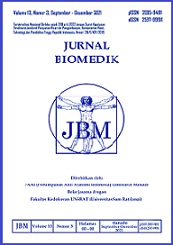THE COMPARISON OF ANKLE BRACHIAL INDEX IN PATIENTS WITH AND WITHOUT ACS IN PROF. DR. R. D. KANDOU HOSPITAL, MANADO
DOI:
https://doi.org/10.35790/jbm.5.2.2013.2594Abstract
Abstrak: Walaupun merupakan pengukuran sederhana dan non-invasif, ankle brachial index (ABI) menunjukkan sensitifitas dan spesifisitas yang tinggi dalam mendiagnosis penyakit arteri perifer pada nilai ABI ≤0,9. ABI juga merupakan indikator yang kuat untuk mengetahui penyakit aterosklerosis pada area vaskular lainnya. Penelitian ini bertujuan untuk menentukan perbandingan antara ABI pada pasien dengan atau tanpa sindroma koroner akut (SKA). Penelitian ini menggunakan analisis analitik observasional dengan desain potong lintang. Subyek penelitian ialah pasien dengan SKA dan pasien tanpa SKA yang datang ke Departemen Kardiologi dan Pembuluh Darah RSU Prof. Dr. R.D Kandou, Manado bulan September-Desember 2012. Nilai normal ABI yaitu >0,9 dan <1,4, sedangkan ABI <0,9 perlu dipertimbangkan abnormal. Nilai ABI >1,4 dipertimbangkan tidak valid dan diekslusi. Hubungan antara variabel dievaluasi menggunakan SPSS. Hasil penelitian memperlihatkan 33 pasien SKA (72,8% laki-laki) dan 33 pasien tanpa SKA (81,8% laki-laki) sebagai subyek penelitian. Rerata usia pasien SKA 57 tahun dan tanpa SKA 52,3 tahun. Angka kejadian pasien SKA dengan ABI abnormal lebih tinggi, yaitu 82,1% vs 17,9% (P < 0,001). Uji chi-square menunjukkan terdapatnya hubungan antara SKA dan peningkatan risiko ABI abnormal (OR 12, P < 0,05). Simpulan: Sindroma koroner akut berhubungan dengan peningkatan risiko dari ABI abnormal.
Kata kunci: Ankle brachial index, sindroma koroner akut.
Â
Â
Abstract: Although the ankle-brachial index (ABI) is a simple and non-invasive measurement, it shows a high sensitivity and specificity in the diagnosis of peripheral arterial disease (PAD) when its value is ≤0.9. Moreover, ABI is a powerful indicator of atherosclerotic diseases in other vascular areas. This study aimed to determine the comparison between ankle brachial indices (ABI) in patients with or without acute coronary syndrome (ACS). This was an analytical observational study with a cross sectional design. We measured ABI indices in 33 patients with ACS and 33 patients without ACS admitted to the Department of Cardiology and Vascular Medicine, Prof. Dr. R.D. Kandou Hospital, Manado. The normal ABI is >0.9 and <1.4. However, ABI <0.9 was considered as abnormal. On the other hand, ABI >1.4 was considered invalid and then excluded. The association of variables was evaluated by SPSS software. The results showed that there were 33 ACS patients (72.8% male) and 33 patient without ACS (81.8% male). ACS patients were older (57 vs 52.3 years). ACS patients had more prevalent abnormal ABI (82.1% vs 17.9%; P < 0.001). Chi square test showed that ACS was associated with an increased risk of abnormal ABI (OR 12, P < 0.05). Conclusion: ACS was associated with an increased risk of abnormal ABI.
Keywords: ankle brachial index, acute coronary syndrome.
Downloads
Issue
Section
License
Penyunting menerima sumbangan tulisan yang BELUM PERNAH diterbitkan dalam media lain. Naskah yang masuk dievaluasi dan disunting keseragaman format istilah dan cara penulisan sesuai dengan format penulisan yang terlampir dalam jurnal ini.
Segala isi dan permasalahan mengenai tulisan yang yang diterbitkan dalam jurnal menjadi tanggung jawab penuh dari penulis.







